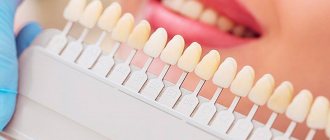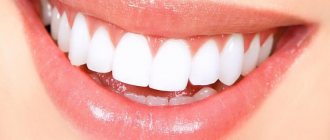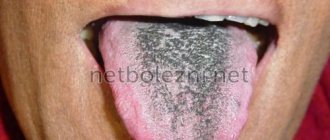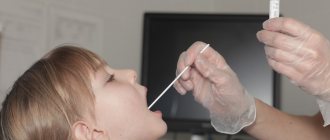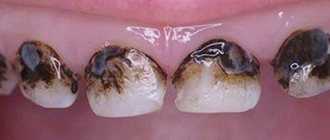The key to health is proper body care from childhood. This also applies to the oral cavity.
Parents should closely monitor the condition of the child's oral cavity. But sometimes, despite all efforts, proper care and a healthy diet, you may notice a deterioration in the condition of your teeth. A common problem is the presence of a yellow coating on them. Often parents consider this situation to pass and not require attention or treatment. And this is wrong! Yellow plaque on a child’s teeth can be either a symptom of problems in the body or an independent disease, which, if left untreated, can lead to various complications in the future.
Causes of yellow teeth
Most often, children's teeth turn yellow due to parental neglect. They must understand that they need to take care of their oral cavity from the moment the first tooth emerges. In advanced conditions, plaque removal will be required. The causes of yellowness may be hidden in acquired diseases. The color of children's crowns is negatively affected by jaundice, as brown spots appear. Also, a dark shade may appear due to problematic digestion.
As a result of mechanical damage, the enamel may crack or chip. And, as a result, yellow spots appear. The pathology is caused by hypoplasia of the enamel layer, under which there is yellowish dentin. In this case, the teeth are already yellow at the time of eruption. Factors in the development of hypoplasia include pathologies of the mother during pregnancy. After all, organs are laid down and mineralized in the womb. Precipitating factors include maternal infections and toxicosis, birth trauma, and prematurity of the infant.
Rare diseases can also be to blame for yellowness. We are talking about dentinogenesis imperfecta and amelogenesis. The first pathology develops with a congenital disorder of the dentin development process. And the second disease is associated with improper formation of the enamel layer. Most often, such anomalies are characteristic of girls. Their treatment is complex and must be started immediately after the units appear.
Eating junk food
Often, yellow teeth in a child are the result of food dyes. This situation is caused by frequent consumption of pumpkin and carrot juice. Orange dyes penetrate microcracks very easily, causing the crown to turn yellowish. Coloring vegetables, berries and fruits, for example, beets or blueberries, also work. Their bright color stays on little teeth!
It is necessary to remember the negative impact on acid units. It could be a too sour apple or applesauce, orange or lemon juice. They can cause acid necrosis. The cracks that appear are immediately filled with dyes and the crowns become dark. It should be noted that iron also affects the shade of enamel. Most often, this situation is typical for well water in rural areas where there are no filters.
A separate conversation about sweets, baked goods, candies, chewing gum with sugar. Particles of these products that remain in the mouth provide a favorable environment for bacteria and pathogenic microorganisms that settle in plaque. Here it is appropriate to remember that the most harmful food is its increased dose!
Poor oral hygiene
Children who do not know how to brush their teeth are most at risk of developing unsightly stains. Therefore, it is important to teach your child how to properly use a brush and toothpaste. It is good if parents keep this process under control. Well, when the situation is difficult, you need to have your teeth cleaned of yellow plaque by a professional hygienist. Only daily procedures at home will consolidate the results and prolong the effect.
- The first incisors are wiped with a soft bristle brush after any feeding.
- When the baby learns to hold the hygiene instrument himself, he needs to be taught the rules of brushing his teeth.
- The brush and paste are selected according to age. The dentist will provide invaluable assistance with this.
- Parents should monitor the cleaning process until 8-10 years of age.
- Children with orthodontic elements are subject to special monitoring. Monthly professional cleaning is the norm for these guys.
With improper care, unsightly plaque, stones and plaques appear. This worsens the child’s appearance and increases the risk of developing dental diseases. We are talking about caries, gingivitis, periodontal disease, and pathologies of the ENT organs.
Taking medications
Some medications cause enamel discoloration. This group of antibiotics primarily includes tetracycline and amoxicillin. If taken by a pregnant woman, it usually causes her baby's teeth to turn yellow. Often these drugs are prescribed to children themselves, even up to one year old. Their frequent use almost always contributes to darkening of the enamel. What to do? In such a situation, hygienic cleaning of the oral cavity is indicated. Professional dentistry will correct the unsightly condition. “Tetracycline teeth” can be whitened using modern technologies. Of course, such procedures should be prescribed to the child by a doctor.
Genetic predisposition
It has long been proven that the color of units is strongly influenced by genetics. If parents have dull teeth, then it is not surprising that the same yellow spots will appear on the child’s teeth. True, the factor of heredity does not occur often, so it cannot be called determining. But you shouldn’t write off genetics either. Today, more and more medical scientists are proving its importance. When diagnosing and developing a treatment program, the dentist must take into account the genetic line so that the therapy is effective.
Poor maternal nutrition during pregnancy
During the period of bearing a child, a woman must eat properly and nutritiously in order to receive valuable microelements and vitamins from food. If the diet is unbalanced, the fetus does not develop fully. From birth, such babies have thinned enamel due to the fact that even in the womb there was a deficiency of nutrients, especially calcium, vitamin and fluoride. Brown dentin will be visible through the thin layer. This causes yellow plaque on the child’s teeth. Therefore, a prerequisite for the proper development of the fetus is the rational nutrition of its mother.
To prevent the child’s teeth from deteriorating, the mother must have enough calcium and fluoride. A powerful source of calcium is sesame. The seed must be thoroughly crushed or chewed to release the beneficial trace element. Don't forget about bananas, salmon, broccoli and olive oil. To replenish fluoride reserves, you need to include avocados, carrots, cucumbers, and dates in your diet.
Consequences
Initially, plaque on children's teeth is white; if it is not cleaned, it accumulates, is stained by food and turns yellow.
- If you do not clean the tooth enamel from such plaque, harmful bacteria (lactobacteria and streptococci) develop and rapidly multiply in it; this process is accompanied by the release of acids that destroy the enamel and provoke the development of caries.
- If the process of plaque formation and accumulation is left to chance, it will begin to grow in volume, gradually penetrating under the gum groove .
Then, due to the dense layer of food debris and bacteria, the tooth stops receiving oxygen, which leads to the rapid proliferation of bacteria and further inflammatory process in the gums. Inflammation of the gums is a natural reaction of the child’s body, the main purpose of which is to destroy harmful microorganisms that have a negative impact on the child’s immunity. - Due to the toxic effect of bacteria on the body, the following side effects may occur:
- Headache.
- With diseases such as gingivitis and periodontitis, gastrointestinal diseases of infectious etiology are possible.
- Pneumonia.
- Blood poisoning.
- Plaque forms near the large salivary glands , which is difficult to clean and remove, despite the beneficial effect of saliva on the enamel. This is due to the fact that saliva does not have direct access to the teeth, and when faced with yellow plaque, it leaves a small amount of mineral substances on it. After a short period of time, this process turns soft deposits into hard deposits and forms tartar.
Yellowness of teeth in a child 1-3 years old
It happens that this problem is not given due attention. Parents mistakenly believe that a one-year-old child with his baby teeth does not need a dental examination. After all, these units are a temporary phenomenon, so there will be no harm from their pathology. In reality, everything is completely different. If you do not visit the dentist in a timely manner, then problems in the form of darkening of the crowns in the future will develop into serious anomalies of the oral cavity. What should parents do?
- Once the incisors appear, they need to be wiped with a damp cloth after feeding.
- When your child turns 1 year old and has 8 units, start cleaning them with a toothbrush without toothpaste. It should be small in size with nice bristles.
- After the child turns 2 years old, begin to teach him to be independent in matters of oral hygiene, then at 2.5 years he will be able to carry out this procedure himself.
Consult your doctor about the choice of baby toothpaste. After all, it is very important to approach it correctly. Do not use products that are oversaturated with flavors and dyes.
Yellow spots on teeth
Yellow spots occur due to tartar, trauma, caries, as well as problems during pregnancy and living conditions. The problem often occurs in very young children (up to one year old). These include hygienic violations and dry air in which he is forced to constantly be.
In any case, regardless of the cause of this pathology, you need to consult a dentist. Regular brushing, dental checkups, and flossing can help reduce the risk. It is also recommended to have your teeth professionally cleaned at your dentist's office twice a year. Significantly increases the effectiveness of prevention by excluding from the diet foods that contribute to tooth decay. A similar pathology can also occur in adults.
Yellow plaque in children over 7 years old
Deposits discovered during school age are most often associated with improper tooth brushing procedures. It is important that a suitable brush is selected taking into account the level of sensitivity of the gum tissue. Special care is not required when performing routine procedures systematically. True, if the situation is seriously advanced, then you cannot do without a visit to the dentist. When a child is 8 years old or older, teeth cleaning using the Air Flow method is prescribed, if necessary. This procedure is safe and painless.
A harbinger of pathology is bad breath and a slippery coating on the crowns and gums. A timely cleaning procedure will prevent the mineralization of soft plaque, which often happens at this age. Refined and soft carbohydrate foods should be limited. Such products get clogged into the interdental spaces. It is useful to give children solid vegetables and fruits, for example, carrots or apples. Remember that proper hygiene is the key to oral health and the best remedy against yellow discolouration!
How to get rid of yellow plaque on children's teeth?
The main thing is to determine why the child has yellow teeth. And, based on the causes of the problem, begin a comprehensive fight against it.
It is important to understand that even if baby teeth turn yellow, it means that something is wrong in the body. Yes, baby teeth will be replaced by permanent teeth. But the problem will remain and will only get worse over time.
What to do to cope with yellowing of teeth in a child 1-2 years old or older?
Watch your diet
First of all, you need to pay attention to the baby’s diet. Tea, sweets, carbonated drinks are the cause of early yellowing of teeth. Additionally, natural foods such as pumpkin can also stain enamel. It is important that the diet is balanced. It is important that the child eats not only soft, but also hard vegetables and fruits. This will not only cleanse your teeth of plaque, but also strengthen them.
Teach hygiene skills
It is necessary to teach your child how to properly brush his teeth on his own and monitor this process. Paste and brush, mouth rinses and other hygiene equipment should be appropriate for the baby’s age.
To maintain oral hygiene, it is recommended to use cleansing wipes, for example, Asepta Baby, made in the form of a fingertip. They gently cleanse teeth and gums of plaque and disinfect the oral cavity.
After the child has 5-6 teeth, you can start brushing them. It is important that parents themselves know how this process should proceed correctly. You can consult your dentist before starting.
It is also important to choose suitable hygiene products, for example, Asepta Baby toothpastes for children with a reduced amount of fluoride in the body and special toothbrushes for their first teeth. The cleaning process must be supervised by adults.
To quickly get rid of yellow teeth, dentists recommend using one of the following methods:
- Mechanical cleaning. It is suitable for cleaning permanent teeth and should be performed by a specialist. This procedure cannot be carried out frequently. In addition, it is contraindicated for those whose teeth have turned yellow due to the thinness of the enamel.
- Use of bleaching agents. They are either used in the form of ointments, or they are offered to rinse the mouth. The effect from them comes more slowly than from mechanical cleaning, but in general they are a more gentle method of whitening. Attention: whitening products have age restrictions! Consult a specialist before using them!
- Use of ultraviolet lamps. This method is especially effective if the teeth have turned yellow due to the use of antibiotics or an unhealthy diet with an abundance of sugar or food coloring.
- Coating teeth with special solutions. For example, silver or fluoride varnish. This will not only solve the problem of yellowness, but also protect the enamel from possible caries or other damage. Also recommended for permanent teeth.
What to do with a child's yellow teeth
The choice of treatment technology depends on the disease and the phase of its development. Light yellowness can be removed with special pastes. More severe cases require professional cleanings by a dentist. For older teenagers, ultrasonic teeth cleaning is used. If there is a serious need to use a skeler, the procedure is carried out delicately and with caution. The cost of procedures in our center is affordable, as we always pursue a reasonable pricing policy.
At the appointment with our dentist, the child will be mentally prepared for therapy in order to prevent fear. The level of oral hygiene is determined by special indicators. Professional cleaning procedures are painless. This can be a rotating brush, which works well on both the oral and vestibular sides. After such manipulations, as a rule, a hygiene lesson is conducted in a playful way.
How to clean at home?
Before you try to clean teeth from yellow plaque using traditional methods, thoroughly clean your baby's teeth with a good brush and toothpaste . If this does not help, and the plaque remains, then these simple methods will come to your aid.
Cleaning with activated carbon
- Take 1 tablet and grind it into powder.
- Then add a little boiled water and mix the 2 components with a toothpick until a thick paste forms.
- Apply the resulting charcoal mixture to a children's toothbrush without adding toothpaste, and thoroughly brush all teeth for 2-3 minutes.
- Rinse your mouth generously with warm water.
Using fresh lemon
Lemon will help cope only with a soft yellow coating (in the early stages):
- Take a lemon.
- Cut a slice of 5-6 mm.
- Use it to brush your child's teeth for 1-2 minutes.
If such cleaning causes discomfort or unpleasant sensations in the child, postpone the procedure for several days.
Uses of baking soda
- Apply a small amount of toothpaste to your toothbrush.
- Sprinkle soda on top.
- Thoroughly clean children's baby teeth from yellow plaque.
During such cleaning, you should not press hard on the brush or make sharp, fast movements. If you ignore this advice, you risk damaging your enamel or scratching your gums.
The disadvantage of such cleaning is its aggressiveness ; such cleaning should be used only as a last resort when other methods are not effective. Brushing your teeth with baking soda can be done no more than once a week.
Cleaning eggplant with ash
Despite the strangeness and unusualness of the cleaning method, it is quite effective.
- Remove the skin from the eggplant and burn it over a fire until it becomes an ash powder.
- Apply ash to a brush and rub it on your teeth.
- Then brush as usual and rinse your mouth thoroughly with warm water.
Using strawberry puree
- Take 100 grams of strawberries, rinse thoroughly and puree them with a blender.
- Apply the mixture evenly to all teeth and leave for 1-2 minutes.
The plaque can be removed with the help of the acid that the berry produces. This method should not be used frequently so as not to damage tooth enamel.
Also, a good way to remove yellow plaque from the surface of teeth is to include fresh fruits and vegetables in your child’s daily diet. Remember, any changes in the color and uniformity of the enamel structure should alert you. In order not to waste time and not to deprive your baby of a beautiful smile in the future, regularly visit the dentist’s office with your child .
Preventive measures
To prevent yellowing of teeth, it is important to carry out all hygiene measures efficiently and on time. We are talking about twice daily cleaning of units, even dairy ones. It’s good if parents take their child to the dentist once every 60 days. The basis of dental health is a balanced and proper diet. As for the frequency of professional cleaning, it should be carried out once every six months. Don't forget to change your toothbrushes and toothpastes on time. Teach your child to oral hygiene from an early age, then dental problems will be minimized.
Disease prevention
- Carefully perform hygienic procedures for caring for teeth and oral cavity.
- Follow a diet that contains a balance of animal and plant foods rich in vitamins and minerals.
- Avoid consumption of sweet confectionery products and sweet carbonated water.
- Take a multivitamin complex.
- Get your teeth checked regularly by your dentist.
If you find chalky stains on your teeth, you must make an appointment with a dentist, who will help determine the nature of such stains and give recommendations and prescribe a course of treatment.

